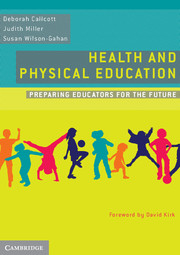Book contents
- Frontmatter
- Foreword
- Contents
- About the authors
- Acknowledgments
- Chapter 1 Introduction
- Chapter 2 The foundation of movement skills
- Chapter 3 Teaching inclusively
- Chapter 4 What all teachers need to know about movement
- Chapter 5 Pedagogy
- Chapter 6 Planning for teaching and learning
- Chapter 7 ICT and general capabilities in the Australian Curriculum
- Chapter 8 Assessment in health and physical education
- Chapter 9 Health education
- Glossary
- Bibliography
- Index
- References
Chapter 6 - Planning for teaching and learning
- Frontmatter
- Foreword
- Contents
- About the authors
- Acknowledgments
- Chapter 1 Introduction
- Chapter 2 The foundation of movement skills
- Chapter 3 Teaching inclusively
- Chapter 4 What all teachers need to know about movement
- Chapter 5 Pedagogy
- Chapter 6 Planning for teaching and learning
- Chapter 7 ICT and general capabilities in the Australian Curriculum
- Chapter 8 Assessment in health and physical education
- Chapter 9 Health education
- Glossary
- Bibliography
- Index
- References
Summary
Learning objectives
By engaging with the text in this chapter, students will be able to:
understand the purpose of the curriculum and how it is utilised in teaching and learning
understand what informs planning for teaching and learning
recognise the relationship between yearly plans or scope and sequence, teaching programs, unit plans and lesson plans
know how to develop yearly plans and write unit overviews and lesson plans
achieve a balance of curriculum and activities in planning, teaching and learning
address student needs and interests in the planning process
create units of work and lessons that are inclusive and cater for diverse needs.
Lily is undertaking her internship in a large coeducational city school. Her mentor teacher has told her she can teach the Nutrition unit with Year 9 and Relationships with Year 7 in the Health Education unit, and ‘just pick something you like for practical lessons’. There is no work program based on the current curriculum for Years 7–10 and there are no unit overviews. She asks her mentor what the students have done before and he says swimming, cricket, soccer and touch. On the day of her visit to the school she has the opportunity to chat with some non-participants about health and physical education. She discovers that they dislike the subject because they ‘always do the same sports and every year they learn the same stuff in Health Education’. Each class has two lessons per week of ‘practical’ and one lesson of ‘theory’. Lily would like to try some new activities to engage the disengaged in movement and physical activities and to revitalise interest in health education. She asks her mentor if it is possible for her to teach European handball, dance and ultimate disc and if it is alright for her to make up her own titles for the Health Ed units and to teach some of the Relationships unit through physical activity. He says yes but is sceptical about the level of student interest in dance. This chapter explores the steps Lily must take when planning her units of work, considers the documents she needs to refer to, and discusses the human, material and information resources she needs to consider and access.
- Type
- Chapter
- Information
- Health and Physical EducationPreparing Educators for the Future, pp. 98 - 120Publisher: Cambridge University PressPrint publication year: 2012



